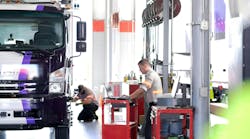Editor's note: This is the third part of a series on truck automation. Read Part 1 and Part 2.
One of the biggest challenges in the future world of autonomous vehicles is with the government — which builds, maintains and polices U.S. roads — keeping up with self-driving technology.
Only eight state legislatures have not considered any autonomous driving legislation, according to the Brookings Institution. Twenty-two states and the District of Columbia have passed laws about autonomous vehicles, another 10 governors have issued executive orders about the emerging technology and, as of last year, another 10 state legislatures have pending legislation.
Weather in the Southwest has been the most inviting for autonomous vehicle testing. While California and Arizona get some of the most publicity about automated testing, more temperate climate states such as Ohio are already planning for the future.
DriveOhio, an Ohio Dept. of Transportation (DOT) initiative, is attempting to bring together public and private entities involved in the design, development, testing, use and regulation of autonomous and connected technologies. Transportation technology companies can register with DriveOhio to test autonomous vehicles and other next-generation transportation technology in the Midwest state that is a microcosm of the U.S. It offers rural and urban traffic conditions with big cities and small towns, flat terrain in the north and hills and mountains in the south, and a climate that can include a taste of all that Mother Nature has to offer.
Ohio is also “within a single day’s drive of 60% of the North American population,” Governor Mike DeWine recently noted in an October executive order. It reauthorized DriveOhio “as a statewide center for advancing smart mobility solutions under five (SMART) pillars: safety, mobility, access, reliability and talent.
DriveOhio is partnering with the Transportation Research Center, JobsOhio, Air Force Research Laboratory, Smart Columbus, various Ohio municipalities and academic institutions. The Buckeye State already is in the midst of autonomous projects such as the I-270/670 Smart Lane through Columbus, the 33 Smart Mobility Corridor, the I-90 Lake Effect Corridor, SkyVision, and the TRC SmartCenter.
The first self-driving shuttles in the state started rolling through downtown Columbus in late 2018. It was the first phase of a project designed to test, operate and evaluate self-driving vehicles while providing residents and visitors first-hand experience with intelligent transportation, according to DriveOhio. The low-speed transportation shuttles are operated by May Mobility, a self-driving vehicle startup.
Transportation technology company Bosch also has a role in DriveOhio. The company is working with the state and U.S. DOT, and the Liberty, OH-based Transport Research Center to study the impact of automated driving on Ohio roads.
“As part of this project, Bosch will provide technology to help study highway truck automation and evaluate the pros and cons of coordinated platooning in real driving situations,” Jason Roycht, vice president and regional business unit leader of commercial vehicles & off-road for Bosch in North America, announced in October, at the North American Commercial Vehicle Show. “These types of programs provide opportunities for innovation; they provide opportunities for learning. And most of all, they provide the framework to collaborate with the government agencies we’ll need to fully utilize this technology.”
Roycht said that Bosch is looking “to leverage decades of experience, decades of investments, and the manufacturing footprint we have already established on the passenger car side” into the commercial vehicle world.
Editor's note: This is the third part of a series on truck automation. Read Part 1 and Part 2.




